Perils Facing Koalas
Information about koalas, their physiology, behaviour, diet and density has been gathered since early settlement and a pattern has emerged over time.There is now clear statistical evidence showing dramatic declines in koala populations across Queensland. The reasons for this decline varies over time.
A report undertaken by Uniquest – SEQ Koala Population Modelling Study in 2015 showed a decline in densities of around 80% in the Koala Coast (Redlands) and 54% in the former Pine Rivers Shire between 1996 and 2014, despite current protection measures. In fact, rather than a showing of the rate of decline there was evidence to suggest the rate of decline had actually accelerated.
This decline is related to many factors including indigenous practices prior to White Settlement, the Fur Trade, Habitat Loss and Fragmentation, Drought, Bushfires, Motor Vehicle Strike, Animal Predation and Disease. More in depth details will be provided for each of these factors.
Habitat Loss and Fragmentation
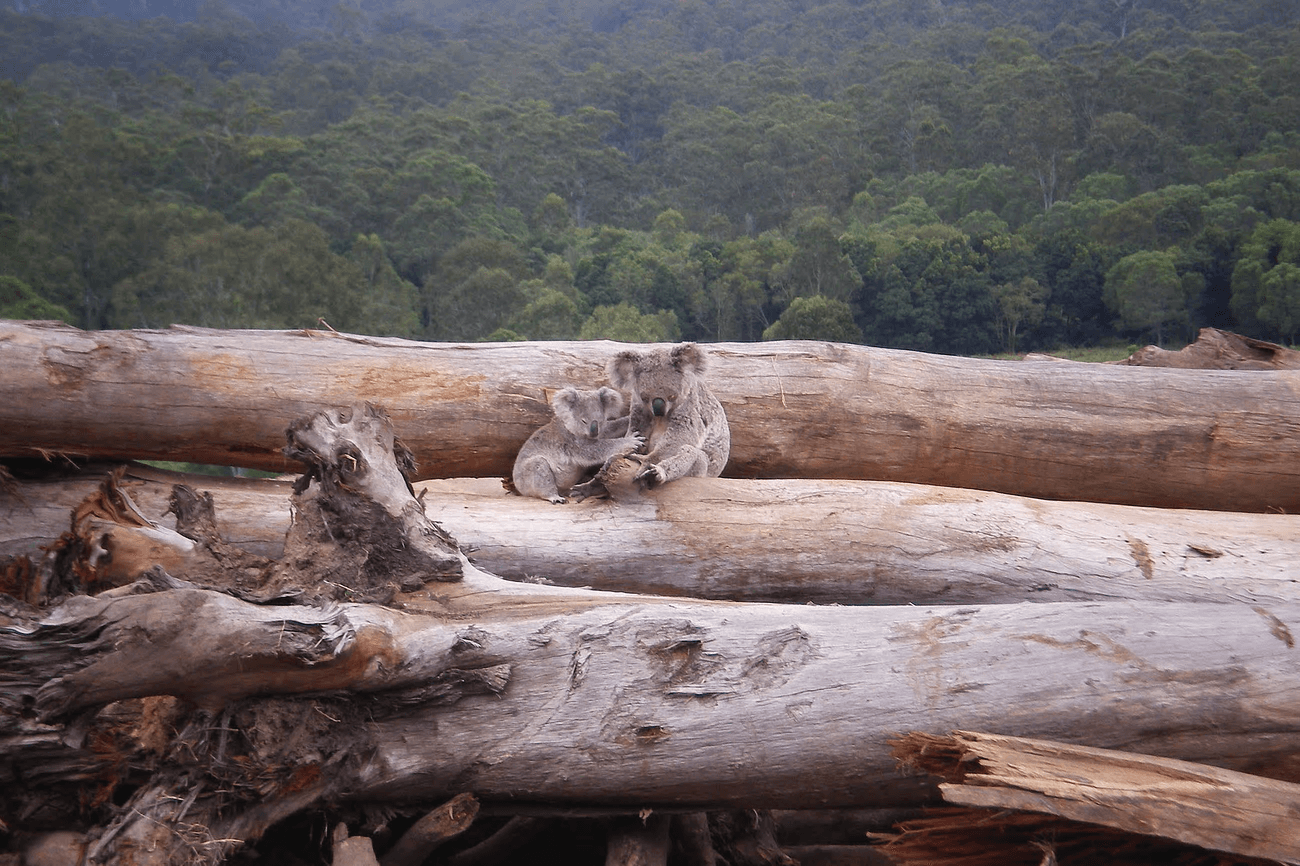
We know from historical accounts that at the time of European settlement, koalas were abundant on the east coast of Australia. Hunting, coupled with rapid habitat loss and fragmentation via land clearing for agricultural/grazing/forestry purposes and urban development, has resulted in dramatic declines in koala numbers. Habitat loss and fragmentation forces koalas to the ground in search of food, shelter and dispersal opportunities. It is at this time they are at risk of being struck by motor vehicles or attacked by domestic, feral and wild dogs. Almost every koala population on the east coast has been decimated as a consequence of habitat loss and fragmentation.
Koala habitat can also be lost through broad-scale clearing in rural and peri-urban areas. bushland degradation from poor management, fire, or pest and weed infestations. Since European settlement, approximately 80% of koala habitat has been cleared. Of the remaining 20% almost none is protected and most occurs on privately-owned land. Clearing for urban development occurs mainly in coastal and adjacent hinterland areas, and is currently a particular threat to koalas across their natural range. Habitats which were once continuous have become divided into separate fragments which is not conducive to their sustainability.
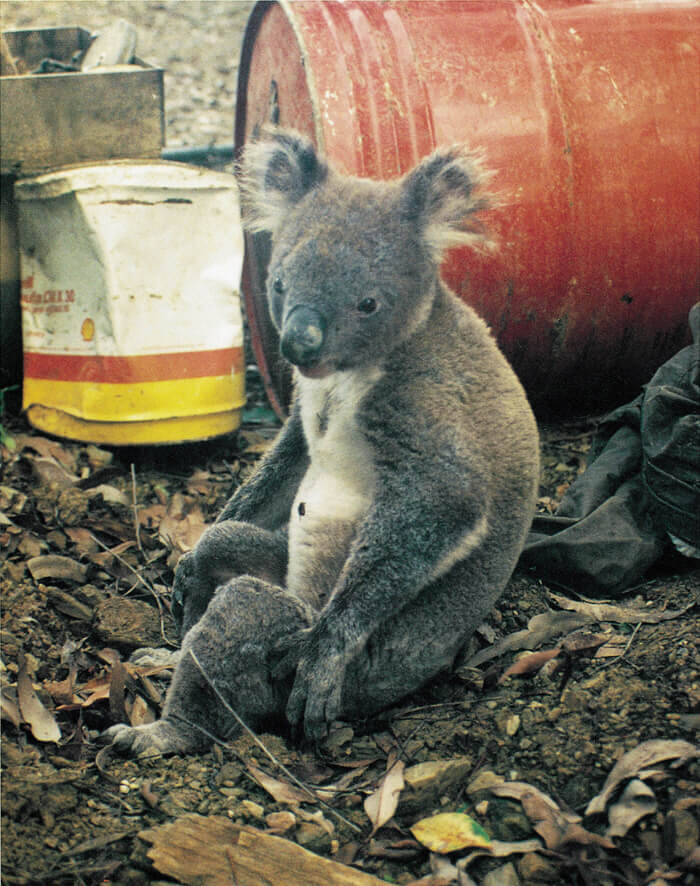

Habitat fragmentation occurs when large blocks of habitat are cut into smaller pieces by development such as roads, railway lines, dams, hydroelectric reservoirs, forestry, agriculture, grazing or housing. Habitat fragmentation affects koalas because they have highly specific habitat requirements and are particularly sensitive to changes and disruptions to their surrounding habitat. Their limited movement capability means that they are unable, or reluctant, to cross gaps in vegetation and move within or among fragmented habitats. The remaining blocks of habitat may be too small to sustain populations of a number of species. Fragmentation within urban and peri urban locations requires koalas to negotiate busy roads, backyards with one or more dogs and deal with the stressors of so doing. Stressors have been linked to a compromised immune system which facilitates the disease process.
There has been and continues to be a lack of political will from all levels of government to address this fundamental issue. Without slowing down and/or stopping habitat loss; extensive replanting of koala food trees and other natives in parks, reserves, and open spaces; rehabilitating remaining habitat to increase its carrying capacity and committing to linking remaining koala habitat, the koala population will continue to head towards extinction. Efforts made to reduce injury and death from disease, motor vehicle strike and predation by dogs may well be wasted if there is minimal to no koala habitat left to sustain and maintain the reproductive viability of the population into the future.

Disease
The long-term survival of the koala is under serious threat from multiple factors, including infectious disease agents such as Chlamydia and koala retrovirus (KoRV).
CHAMYDIAL DISEASE
Chlamydial disease in the koala, Phascolarctos cinereus, has been particularly well studied, given the devastating toll it has taken on this iconic Australian marsupial. Chlamydial infection in koalas is dominated by the species Chlamydia pecorum.
These infections lead to ocular (conjunctivitis) and urogenital/reproductive diseases (cystitis) comparable to Chlamydia trachomatis infections in humans, which include keratoconjunctivitis and scarring in the eye leading to blindness and cystitis/nephritis and reproductive cysts in the urogenital and reproductive tracts, respectively, leading to severe pain and infertility. In both humans and koalas, vaccination has been identified as the most promising avenue of control for this pathogen. What research has achieved is a greater understanding of the immune response to chlamydial infection and vaccination, particularly in koalas, setting the stage for future success.

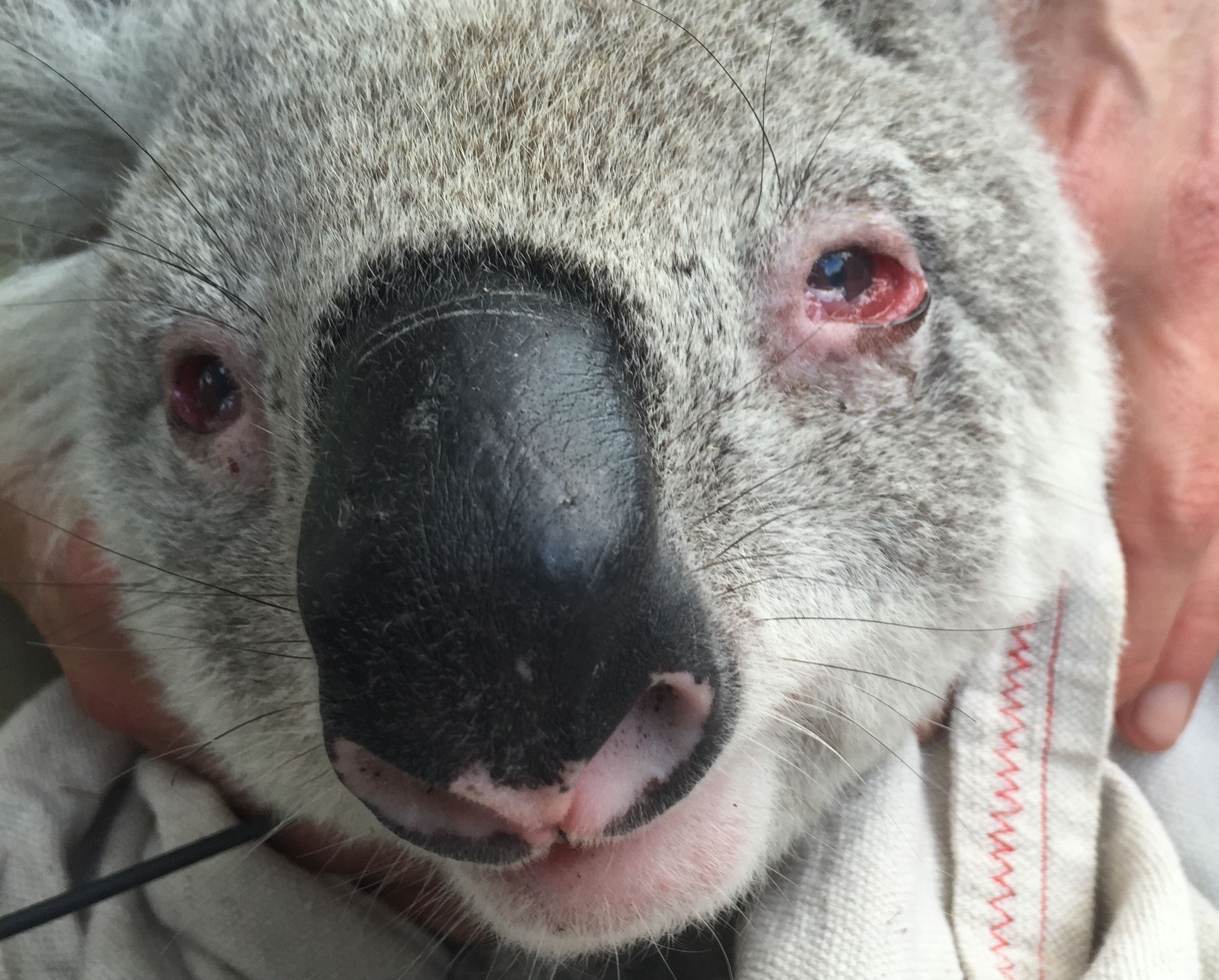
Chlamydiosis is the most significant infectious disease of koalas. It is primarily a systemic sexually transmitted disease caused by Chlamydia pecorum and was responsible for 46% of the 2348 koala admissions to Australia Zoo Wildlife Hospital between 2013 and 2017.
Treatment of chlamydiosis in koalas is complicated by three major factors. Firstly, koalas rely on bacterial fermentation of their high fibre diet making antibiotic therapy a risk. Secondly, they possess efficient metabolic pathways for the excretion of plant toxins and potentially of therapeutic agents. Thirdly, wild koalas, often present to rehabilitation facilities with chronic and severe disease. Traditional anti-Chlamydial antibiotics used in other species may cause fatal dysbiosis in koalas or be excreted before they can be effective. Findings indicate that doxycycline is the current drug of choice for the treatment of chlamydiosis in koalas, with chloramphenicol being the best alternative.
According to the Australian Academy of Science, it is thought that the pathogen was introduced to Australia through infected livestock (sheep and cattle) in the late 1780’s, where it then spread to the koala population.
Unlike koalas and humans, Chlamydia in sheep is not a sexually transmitted disease, but transferred through the animals’ droppings. “It is a gastro-intestinal tract disease so it is transmitted in the faeces and then typically re-enters the gastrointestinal tract when it is swallowed.”
All koalas eat dirt which is thought to contain essential dietary trace elements to keep them healthy, as well as good bacteria for their gut health. Scientists suggest this was probably how the pathogen was introduced into the koala population. Young koalas can also become infected with Chlamydia by eating pap, a nutritious type of faeces, when it is excreted by infected mothers, according to a study published March 12 in the journal Peer J. May 9, 2018.
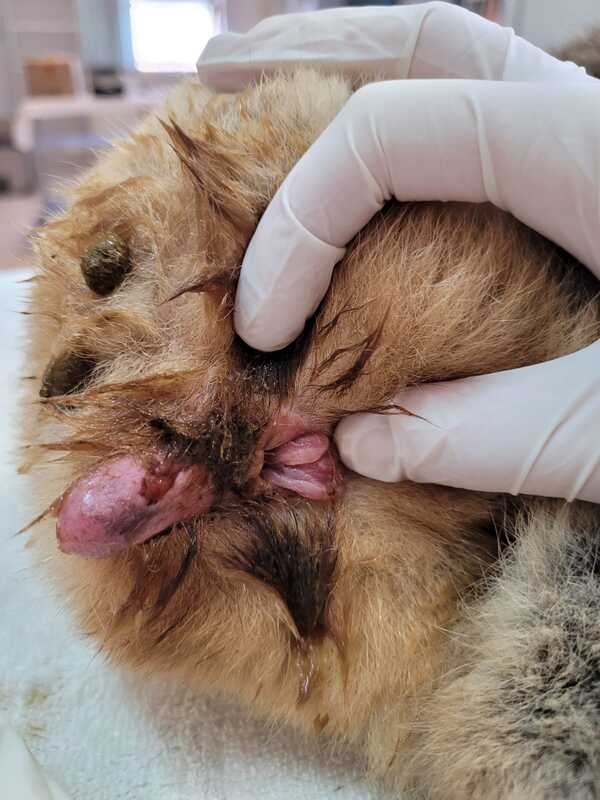
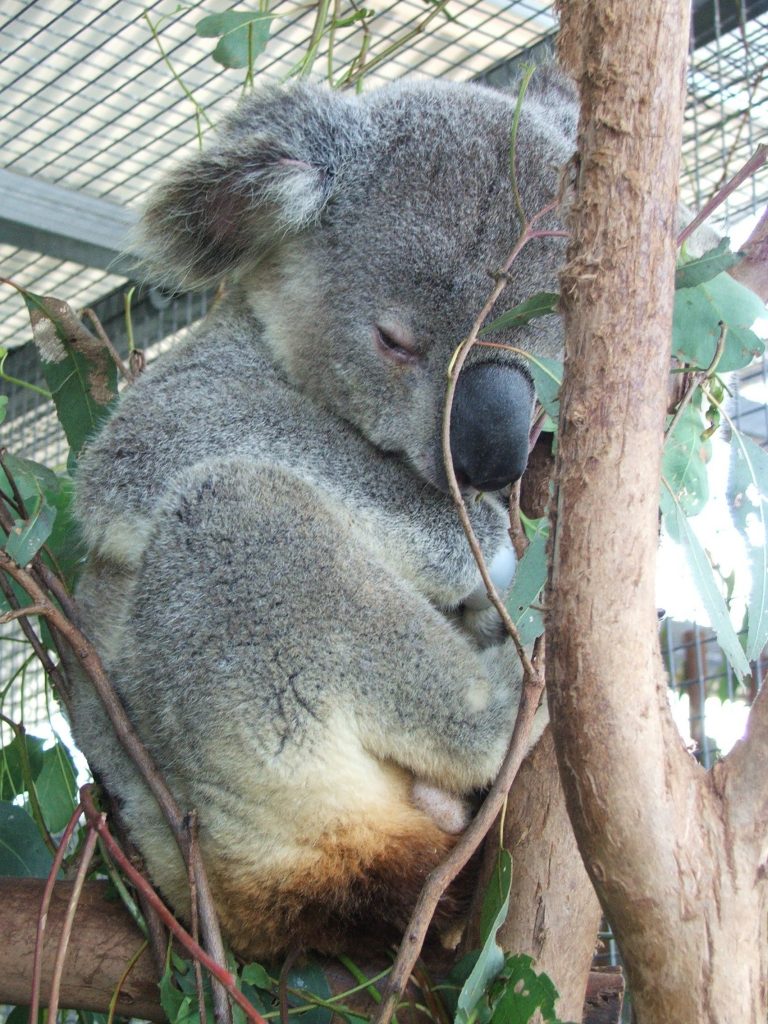
Some surveys of koala populations in Queensland have suggested at least half of wild koalas are infected with the disease — possibly even more. Now, scientists from the University of the Sunshine Coast have begun to crack Chlamydia’s code, shedding more light on exactly how Chlamydia pecorum and its associated disease have changed over time to have such catastrophic impacts for livestock and koalas alike.
In some parts of Australia, up to 90 percent of the local koala population is infected with this sexually transmitted disease (though it’s not the same strain that infects humans). The more common strain, Chlamydia pecorum, is responsible for most of the outbreak in Queensland and cannot be transmitted to humans. The infectious bacteria can severely impact a koala’s health and can in some instances result in death.
KoRV
KoRV is present in both exogenous and endogenous forms, depending on the geographical location of the population. In the northern half of Australia, it is present as an endogenous infection in all koalas, making a case for an urgent need to develop a therapeutic vaccine that might prevent KoRV-associated pathologies in these koalas.
Koalas with the retrovirus usually present with ulcers in the mouth and generally poor body condition. According to Dr Jon Hanger, the koala veterinary specialist credited with discovering the koala retrovirus,9 the disease is considered to be responsible for causing the following medical conditions in koalas:
- leukaemia (a cancer of the blood forming cells);
- myelodysplasia (abnormalities in production of blood cells);
- immunodeficiency syndrome (an AIDS-like condition in koalas); and
- other cancers including lymphoma, osteochondroma and mesothelioma.
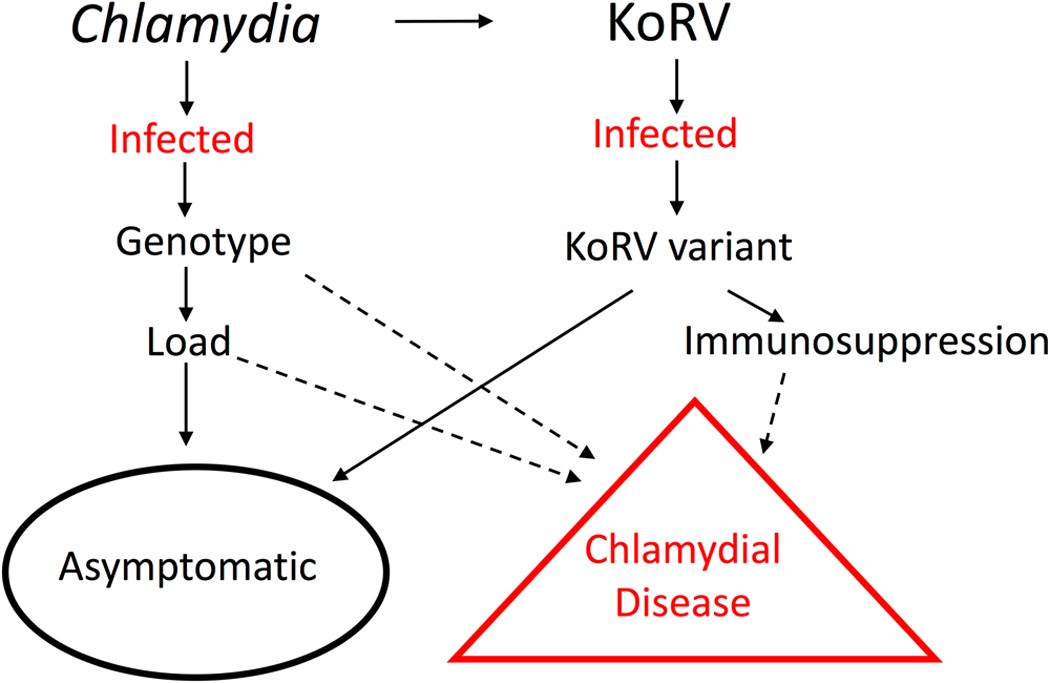
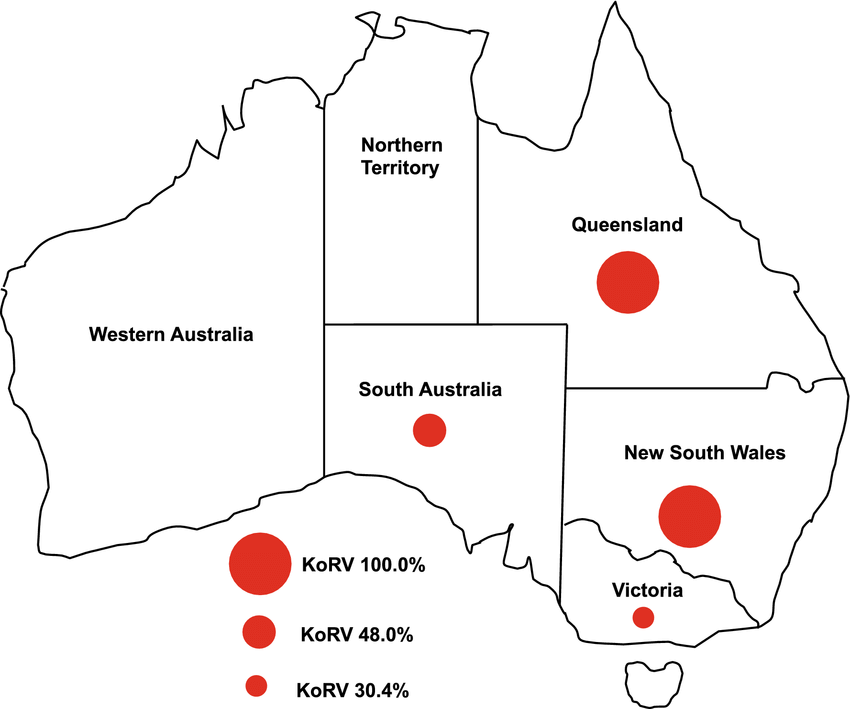
Motor Vehicles
Koalas spend much of their time feeding or resting in trees but they also need to come to ground to move between trees within their home range. This usually occurs at night but koalas can be active during the day as well. Between July and September, koalas will spend more time moving across the ground as adult males search for mates and sub adult/juveniles disperse to find home ranges of their own.
For koalas living within the urban and peri urban regions much of their habitat is now criss-crossed by roads. This puts koalas at great risk of being hit by motor vehicles, particularly at night. This risk increases where traffic volume and speed are greater and where road position and design create ‘black spots’ where koalas are hard to see. Vehicle related koala mortality has the most significant impact on koalas after habitat clearing and fragmentation. Koalas that are injured or killed are predominantly healthy breeding-age animals.
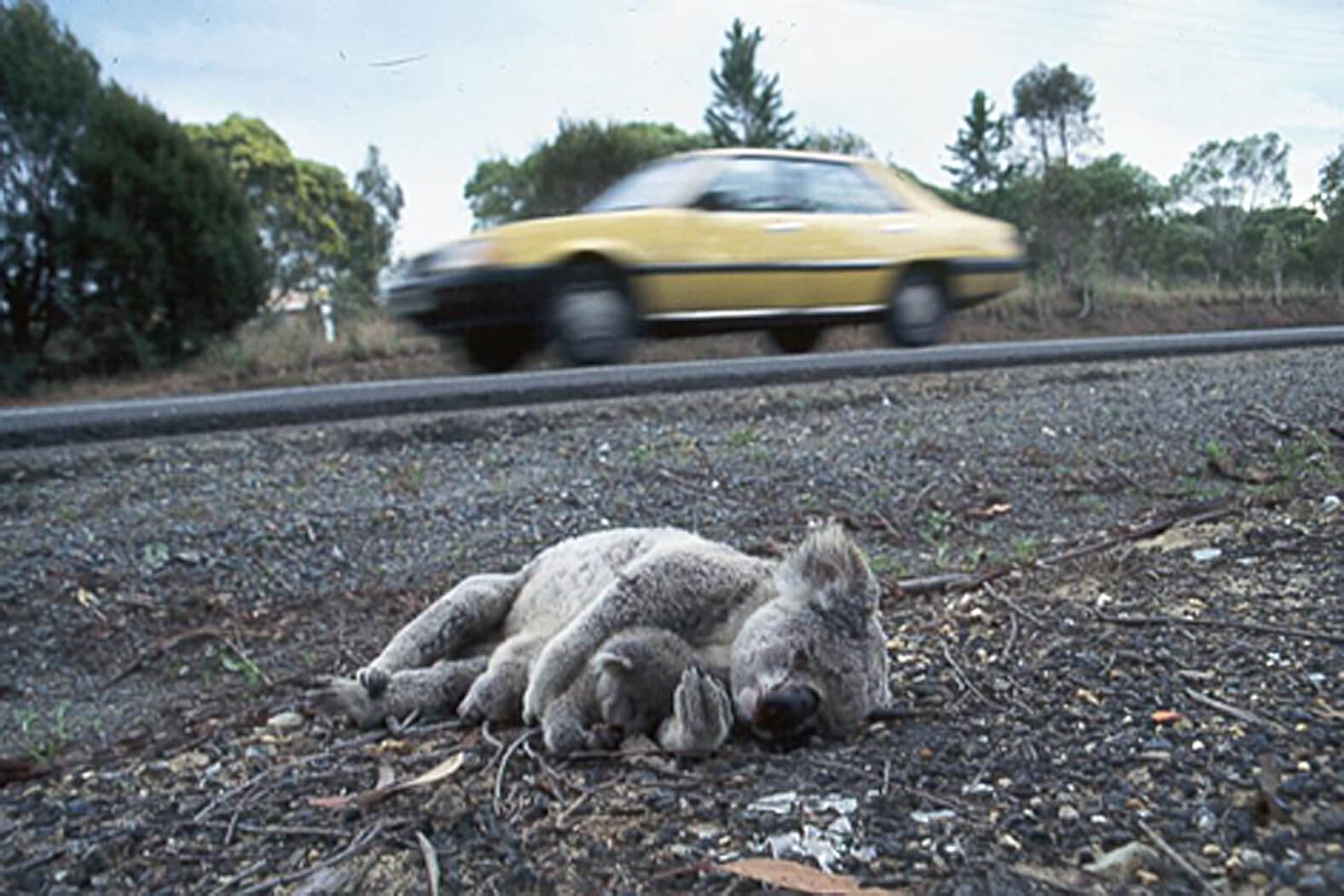

Koalas are not able to understand how dangerous roads can be. When an animal appears from nowhere in front of your vehicle there is often little that can be done to avoid it. By following a few simple practices, you can help to make roads safer for koalas. This may make the difference between accidentally hurting a koala and knowing that you’ve helped one survive. Some of the things that drivers can do are:
- Make sure you are aware of those areas where koalas are known to cross roads (look for ‘koalas cross here’ signs);
- Stay within the recommended speed limits on koala speed zone signs. This will make roads safe for everyone, including wildlife;
- Be alert for koalas and other wildlife crossing the road. Scan the sides of the road for koalas and watch for koala ‘eye shine’ (reflections from an animal’s eyes) at night.
- Report injured or dead koalas that you see on the roadside so that they can be collected by wildlife rescue groups. If the koala is dead, its pouch should be checked for young, which can be cared for and released back into the wild when old enough. Dead koalas can also provide their caecum contents to other koalas including joeys if collected close to the time of their death;
- Contact a wildlife rescue group so that the koala can receive treatment quickly. Only move an injured or dead koala from the road if you can do so safely. An injured koala will bite and scratch, it must be covered with a thick blanket or towel before being handled. A koala can be temporarily housed in a closed cardboard box with a hessian bag or towel on the bottom for the animal to grip on to. Any handling should be carried out quickly to avoid making the koala struggle and causing it unnecessary stress.
- Take extra care driving when koalas are breeding between the months of June to September as this is the time of year when koalas are at most risk to being hit by cars.

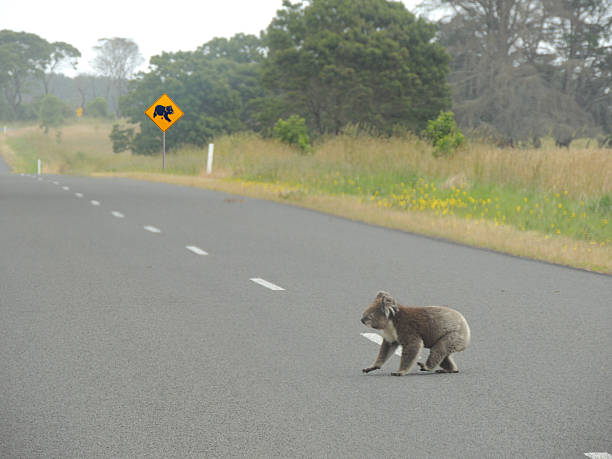
Predators
Dog Attacks
Dog attacks on koalas are among the most significant threats that need to be addressed. It is a basic responsibility of dog owners to ensure that their pets do not injure or kill protected wildlife such as the koala.
- Once attacked, koalas rarely get a second chance, with over 80 percent dying.
- Most attacks on koalas take place in the dog’s own backyard.
- Not all dogs attack koalas. Ninety-six percent of attacks on koalas were by dogs over 10kg. Generally, the larger the dog, the greater the likelihood that it could be responsible for a fatal attack.
- Dog attacks are more likely to occur between July and September (peaking in September). This is when koalas are breeding and therefore more mobile.
- If there are two or more dogs present at a property there is a higher incidence of attack.
- Attacks on sick koalas are no more frequent than for healthy ones.
- It should also be remembered that koalas are capable of defending themselves. They have sharp teeth and claws capable of causing deep wounds and any dog that attacks a koala may risk serious injury.
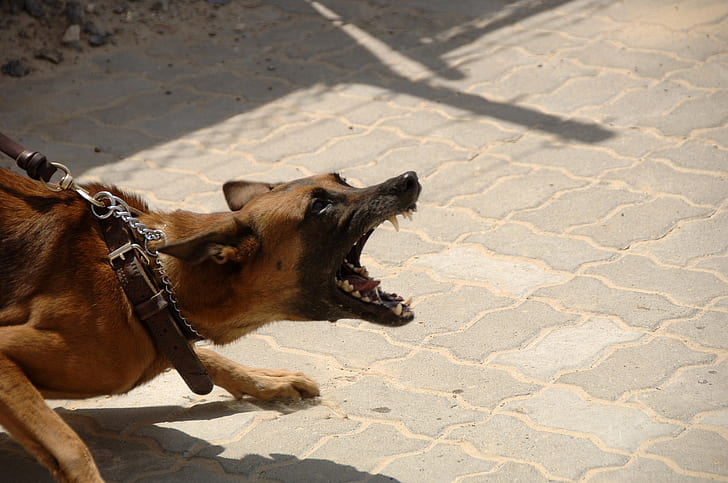
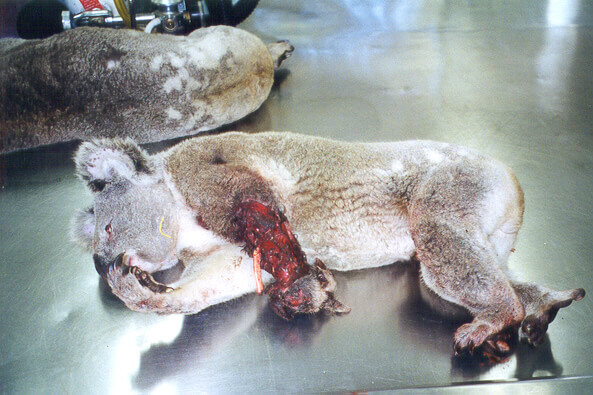
Between July and September, male koalas will be moving around in search of mates and trying to establish their dominance over an area. At this time the weaned young, born the previous year, will also be leaving their mothers and moving into adjoining territories. This is the time of year when koalas are at their most vulnerable to dog attack and dog owners should do whatever they can to keep koalas safe.
Things you can do to make my dog, and property, koala-friendly?
Keep your dog under control at night. Most koala attacks occur at night so limit your dog’s movements at this time to greatly reduce any likelihood of it chasing or catching a koala. Keep your dog inside or on an enclosed deck or veranda at night — where it can be both a better watchdog and a better companion. Kennels and other forms of enclosures can also be used to confine dogs, or they can be kept comfortably on leads — especially if they are given something like a bone to stop them from getting bored.
Don’t assume your dog is koala friendly. Dogs sometimes behave differently when their owner is not present, particularly if a strange person or animal enters what they consider to be their territory. Making sure koalas are safe to traverse your backyard could save you from discovering an injured or dead koala when you return home.
Keep your dog and koalas apart. If a dog is worrying a koala that is in a tree, remove the dog from the area so that the koala can come down from the tree and move out of the area without any further disturbance.


Check the trees on your property to see if koalas are present. Before leaving your dog unsupervised in your yard, check to see if there are any koalas in trees on your property. Ask your neighbours if they have seen koalas in the area recently.
Train your dog to stop chasing other animals. If you are concerned that your dog might chase a koala, another option is to consider obedience training. This will not only protect koalas but also give you greater control over your dog. Advice on obedience training techniques can be provided by dog training schools in your area.
Check with your local government to see what dog owners are required to do to protect koalas from dog attack.
Choose a small dog. If you are getting a new dog and it will be living in an area inhabited by koalas, consider getting one that is unlikely to grow to a size greater than 10kg. Small dog breeds can provide the same companionship and property protection as larger dogs, but pose a lesser threat to koalas.
What should I do if my dog has attacked a koala?
The first thing to do is to remove the dog from the site of the attack. If the koala is injured, you should contact your local wildlife care and rescue organisation by ringing the EPA hotline (1300 130 372). If the koala is dead, its pouch should be checked for young, which can be cared for and ultimately released back into the wild. Dead koalas should also be reported to the EPA or your local wildlife care organisation.
If the koala is alive, it is very important that you do not put yourself in a position to be injured or expose the koala to further injury and stress. Avoid interfering with the koala if possible until a wildlife carer can collect the animal.
You can confine an injured koala temporarily while waiting for a wildlife carer by placing an upturned box or large bin over the top of it with a weight on top. However, if you are forced to catch the koala in order to transport it to a wildlife carer or a vet, there are a number of precautions you can take. Wear thick, long gloves that protect your forearms if they are available, and use a towel or blanket to immobilise the koala before picking it up. The koala should be placed in a cardboard box that can be closed and with a hessian bag or towel on the bottom for it to grip on to. Any handling should be carried out quickly to avoid making the koala struggle and causing it unnecessary stress.
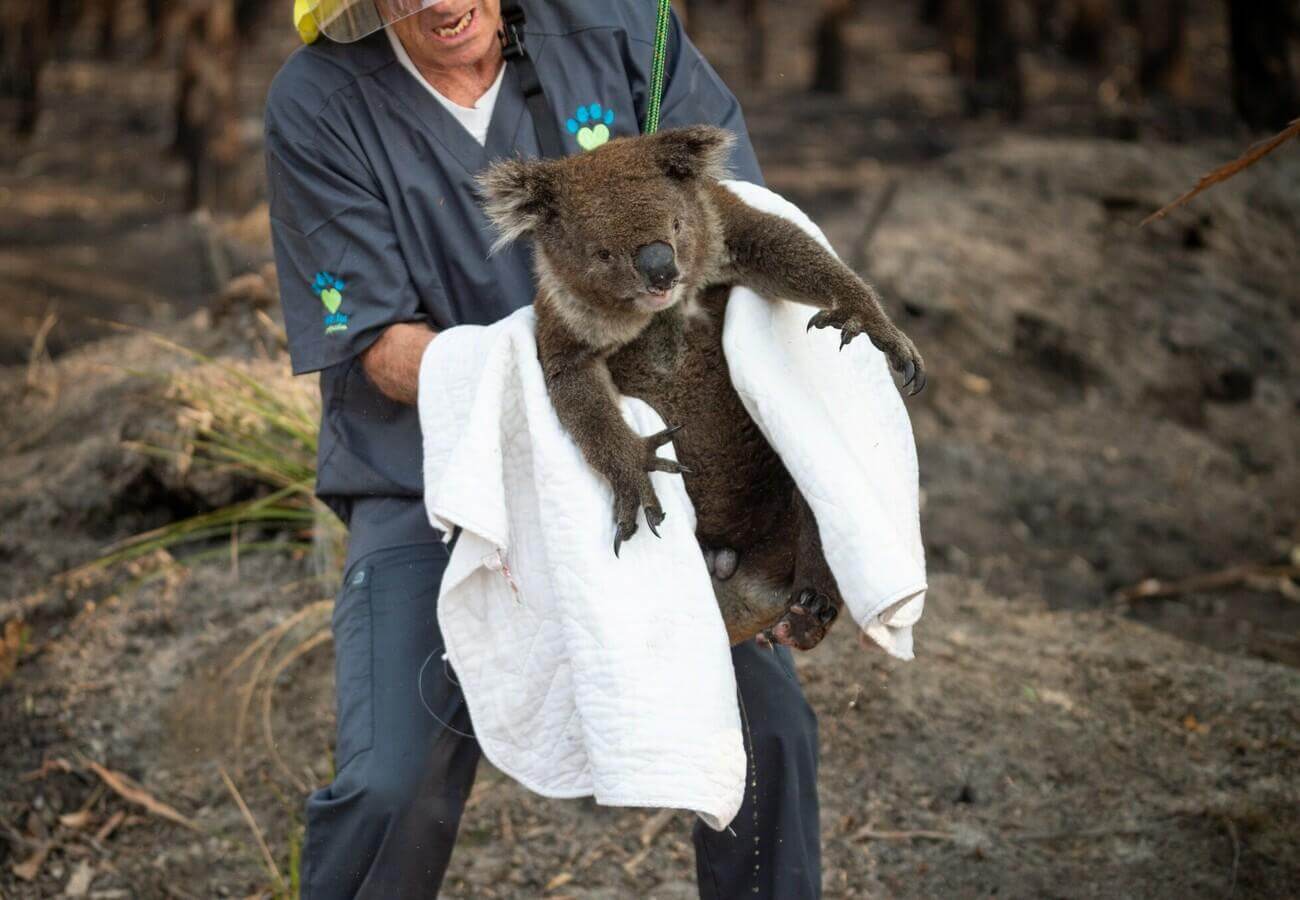
The Fur Trade
The Australian Koala Foundation’s research undertaken in August 2015 sourced its figures from historic auction house records, news archives and other published works. It has revealed at least 8 million koalas were killed for the fur trade, with their pelts shipped to London, the United States and Canada between 1888 and 1927. Koala fur is not only thick and therefore warm; it is also waterproof and commonly used to make hats, gloves and to line coats.
AKF records show that between 1888 and July 1918 at least 4,098,276 koala furs passed through London auction houses. “This figure doesn’t include records from 1911 to 1914. “London wasn’t the only market – records we’ve obtained indicate more than 400,000 pelts were shipped in 1901 alone from Adelaide to the USA. In 1919, 2 million pelts were shipped to the USA, followed by another 2 million in 1924.”
CEO, Ms Tabart said this slaughter saw koalas hunted to functional extinction in South Australia by 1912. “By the 1920s, koalas were reduced to a few hundred individuals in New South Wales and 1000 in Victoria,” she said. This practice was banned in the early 1900s in New South Wales, South Australia and Victoria.
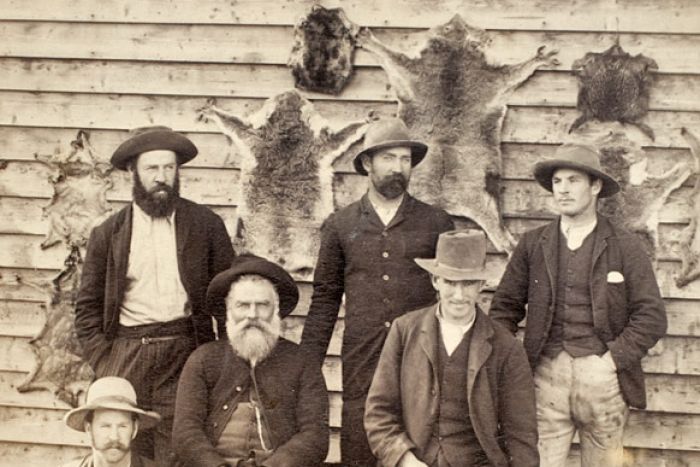
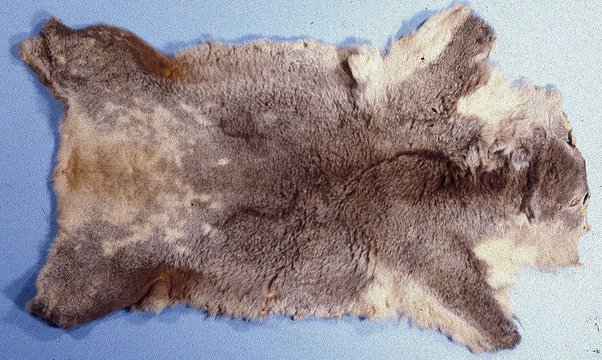
In Queensland it continued until 1927 when the Australian icon was almost driven to extinction following a Queensland Government-endorsed “open season”. The mass killings were etched in history as Black August. Koala hunters killed 600,000 koalas for pelts.
In the weeks leading up to August 1927, the Queensland Government collected licence fees from 10,000 hopeful koala hunters to boost rural employment and in response to reports of uncontrollable koala populations.
- 600,000 koala pelts were collected in Black August alone;
- The death toll may have been as high as 800,000 koalas;
- The pelts were sold at an average price of 56 shillings and 9 pence per dozen;
- 38 Queensland companies were involved in the fur trade;
- The backlash that followed helped topple the Labour government in elections in May 1929;
- The current koala population represents 1% of the population shot before the fur trade. Source: Australian National University.
The killing was finally banned after a massive public backlash in what was thought to be Australia’s first large movement of citizens for a conservation issue. Everyday Queenslanders, led by Brisbane’s Anglican Archbishop Gerald Sharp, recognised the need to protect this iconic animal and campaigned fiercely against that hunting season.
It wasn’t until USA’s then Secretary for Commerce, Herbert Hoover, who later became President, signed an order in 1927 permanently prohibiting koala skin importation, that the koala fur trade was halted. Apparently, as a younger man, President Hoover had spent time in the West Australian goldfields and would have been aware of the importance of this iconic animal to Australia which might have influenced this decision.
Despite the 1927 culling, the koala was only listed as vulnerable to extinction across the whole of Queensland in 2012. Earlier that year, the Queensland Government’s Koala Expert Panel found the population decline showed no sign of stopping. “This decline is related to ongoing habitat loss in south-east Queensland resulting from increasing urbanisation, other threats such as dog attacks and road mortality associated with development, and disease,” the panel wrote in its interim report.

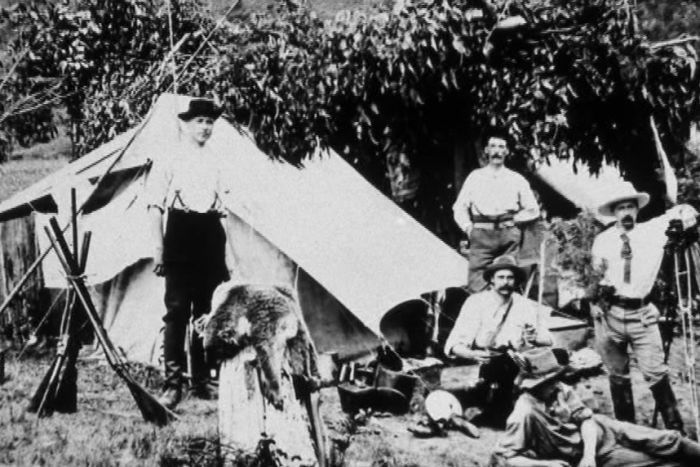
The major threat to koalas today was habitat loss. “Let’s be quite clear, this hideous fur trade wiped out the bulk of our wild koala population,” Ms Tabart said. Ms Tabart said she is offended by the existing scientific literature about the history of koalas as it implies that when European settlers came to Australia, Aboriginal people had hunted them so much that there were low numbers. “White settlers, in my view are completely responsible for wiping out an unthinkable number of koalas, and we still see these effects today.”
Ms Tabart said she is confident that one day she will say sorry to the Aboriginal people for yet another slight on their culture, and that she’s confident the koala was in a healthy state when settlers came in 1788. The current population of approximately 87,000 wild Koalas in Australia represents only 1 per cent of those that were shot for the fur trade.

